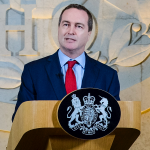If there’s one thing that everyone can agree when it comes to the Online Safety Bill, it’s that it’s taken far too long.
Five years after it was first proposed, it is only now starting on the last leg of its journey, with its introduction to parliament today.
Aside from that, reaction has been what in technical policy circles they call “all over the shop”. No one much likes it, but no one can agree why.
Read more: Couple whose daughter, 15, killed herself after accessing websites welcome new bill
Civil liberties groups say it gives “state backing to big tech censorship on a scale that we have never seen before”.
Critics of big tech argue it fails “to rein in the power of unaccountable Silicon Valley tycoons”.
Startups despair at the drag on profits. Campaigners say it fails to address tech business models.
New law banning cyberflashing to be included in Online Safety Bill
More porn sites face being blocked in UK unless they verify users’ ages
Mark Zuckerberg risks jail if Facebook fails to comply with new online safety law, says Culture Secretary Nadine Dorries
For children’s charities, the bill doesn’t do enough. For academics who study children’s behaviour online, it does far too much.
Even its scope is a matter for debate. For its fans, the bill is “ground-breaking and world-leading”. For others, a small step, not always in the right direction.
These disagreements aren’t just a reflection of people’s different starting positions. Campaigners concerned with freedom of speech will always disagree to a certain extent with charities who want to restrict hate speech, but the debate about the Online Safety Bill goes further than that.
Even after years of debate, there remain substantive differences of opinion about the nature and purpose of the bill, let alone what it will achieve when it finally becomes law.
How can this be? There are three main explanations.
Please use Chrome browser for a more accessible video player
A balancing act between competing pressures
The first – the government’s explanation – is that the Online Safety Bill neatly charts the course between multiple competing pressures.
Although in public ministers describe it as a revolution, in private they hope the bill will be a sensible reform, stopping some of the things we don’t like about the internet (abuse, scams, indecent imagery), while preserving the things we like (convenience, speed, the ability to share ideas freely).
If none of the campaigners are perfectly happy, the thinking goes, that shows they got the balancing act just about right.
“This stuff is difficult,” one minister working on the bill told me after the white paper was published. “We can’t boil the ocean but we can make a difference.”
A botched job
The second explanation is that, faced with multiple competing pressures, the government botched the job.
Instead of picking a side, it tried to please everyone. Instead of balance, it produced an unworkable compromise.
This explanation has the force of history behind it.
Part of the problem with the bill was that, from the start, it wasn’t clear what it was trying to do. It focused on “online harms”, a term that covered everything under the sun. Was it about social media or porn websites? Hate speech or crime? Terrorism or cyberflashing?
Read more: What is the Online Safety Bill and why are some people worried about it?
After every scandal or tragedy, new elements crept in. It can help deal with knife crime! Fight eating disorders! Expose anonymous trolls!
In theory they all fitted together – they were all online, after all – but in practice it often looked like a laundry list of issues without a common theme.
In the weeks before the bill was published, the government was still making changes to incorporate fresh complaints and deal with additional complications. This does not inspire confidence.
As Open Rights Group’s Jim Killock, one of the most acute observers of legislation on technology, put it: “The fact that the bill keeps changing its content after four years of debate should tell everyone that it is a mess, and likely to be a bitter disappointment in practice.”
Basic elements shrouded in confusion
Fudge or balancing act, which account is right? This brings us to the third explanation: we do not know.
The reason that the bill produces such sharp differences in opinion is its most basic elements are shrouded in confusion. Any view of it is possible, because anything could happen.
Take one of the central ideas of the legislation: stopping the spread of harmful content online.
Harm, in this bill, is defined as “psychological harm amounting to at least serious distress”.
Soon, it will be an offence for social media users to post something that might cause this harm and an offence for sites not to stop them.
Follow the Daily podcast on Apple Podcasts, Google Podcasts, Spotify, Spreaker
Will social media firms react by deleting everything that might cause harm, just in case? And why are journalists and media companies given a free pass on this, when so much of the value of social media comes from the fact that anyone can contribute to a debate? We just don’t know – and it’s not clear the government does either.
Then there are new powers given to the secretary of state.
Despite establishing an independent regulator, Ofcom, the bill gives the minister for digital the right to direct companies to remove or keep up content “for reasons of public policy” – that is, for whatever reasons the minister thinks are good at that moment.
When will this power be used? How can we be sure it won’t be abused?
It’s the same with the protections for free speech.
Please use Chrome browser for a more accessible video player
If someone’s post or account gets taken down for an inappropriate comment – something that seems more likely to happen once this new law gets passed – then the bill contains provisions for “a right of action in court for breach of contract”.
Will internet users really go to court to defend their joke or argument? Will anyone be satisfied if they do?
The questions abound.
How frequently will the new regulator levy fines? Can it actually enforce its dramatic-sounding power to jail tech executives, given that in many cases they don’t actually work or live in the UK? Is it even technically possible to check every user’s age on sites that might have adult content?
Remarkable gap between theory and practice
There is more, far more. Any legislation contains a degree of uncertainty, but the gap between theory and practice in the Online Safety Bill is remarkable.
Perhaps this was inevitable, given the territory, but a more piecemeal approach, or one using existing institutions, wouldn’t have yielded such extreme uncertainty.
The police could have been given new funding to prosecute abuse, much of which is already illegal under our current law, or to go after online scams.
Different issues could have been parcelled out in other, more focused legislation.
But it is too late for might-have-beens. The only thing to do now is to watch what happens as the new regime develops.
After all this time, the wait to find out what Online Safety means is not over.
Don’t bet against it still being a work in progress in five more years.






















